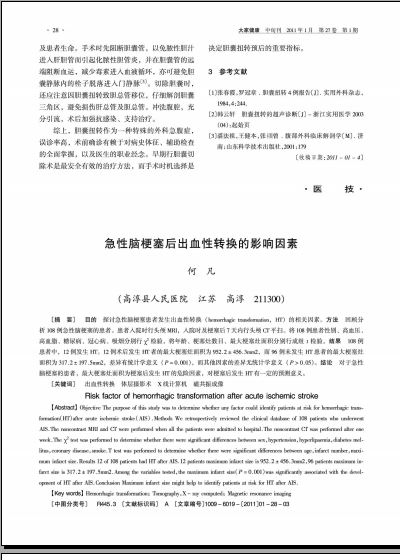急性脑梗塞后出血性转换的影响因素(1)
 |
| 第1页 |
参见附件(2467KB,3页)。
〔摘 要〕 目的 探讨急性脑梗塞患者发生出血性 转换(hemorrhagic transformation,HT)的相关因素。方法 回顾分析108 例急性脑梗塞的患者。患者入院时行头颅MRI,入院时及梗塞后7天内行头颅CT平扫。将108 例患者性别、高血压、高血脂、糖尿病、冠心病、吸烟分别行 2检验,将年龄、梗塞灶 数目、最大梗塞灶面积分别行成组t检验。结果 108例患者中,12例 发生H T。12例术后发生HT者的最大梗塞灶面积为952.2±456.3mm2,而96例未发生HT患者的最大 梗塞灶面积为317.2±197.5mm2,差异有统计学意义(P=0.001),而其他因素的差异 无统 计学意义(P>0.05)。结论 对于急性脑梗塞的患者,最大梗塞灶面 积为梗塞后发生HT的危险因素,对梗塞后发生HT有一定的预测意义。
〔关键词〕 出血性转换 体层摄影术 X线计算机 磁共振成像
Risk factor of hemorrhagic transformation after acute isch emic stroke
【Abstract】 Objective The purpose of this study was to determinewhether any factor could identify patients at risk for hemorrhagic transformati on(HT)after acute ischemic stroke(AIS).Methods We retrospectively reviewed theclinical database of 108 patients who underwent AIS.The noncontrast MRI and CTwere performed when all the patients were admitted to hospital.The noncontrastCT was performed after one week.The 2 test was performed to determine wheth er there were significant differences between sex,hypertension,hyperlipaemia, diabetes mellitus,coronary disease,smoke.T test was performed to determine wh ether there were significant differences between age,infarct number,maximum in farct size.Results 12 of 108 patients had HT after AIS.12 patients maximum inf arct size is 952.2±456.3mm2,96 patients maximum infarct size is 317.2±197 .5mm2.Among the variables tested,the maximum infarct size(P=0.001)was si gnif icantly associated with the development of HT after AIS.Conclusion Maximum infa rct size might help to identify patients at risk for HT after AIS.
【Key words】 Hemorrhagic transformation; Tomography,X-ray comp uted; Magnetic resonance imaging
〔中图分类号〕 R445.3 〔文献标识码〕 A 〔文章编号〕1009-6019- 〔2011〕01-28-03
多年来,脑梗塞是一种严重危害全人类健康的常见病,发病率、死 亡率与致残率都很高〔1〕。而且,临床研究证明脑梗塞患者急性期容易发生出血性 转换(he morrhagic transformation,HT)。红细胞溶解产生的氧化血红蛋白(OxyHb)可加速氧自由基 和脂质过氧化物的产生,这些物质在体内含量过多可造成血管内皮细胞损伤。而且,Kent 〔2〕等认为,HT患者3个月后的临床预后明显差于未发生HT的患者。因此,作者通过分 析脑梗塞病人发生HT的可能相关危险因素,从而指导临床治疗方案的选择。
资料与方法
1、临床资料:回顾性分析2007年1月至2010年10月我院急性缺血性卒中患者。入选标准主要 包括:(1)入院时头颅MRI诊断为急性脑梗塞,并引起神经功能缺损,且头颅CT平扫除外出血 ;(2)梗塞后1-7天及出现头痛等不适症状后复查CT者。排除标准:(1)脑血管畸形或肿瘤等 易导致颅内出血者;(2)入院时无头颅MRI检查或入院后无头颅CT平扫随访者;(3)CT或MRI扫 描过程中患者欠配合导致移动伪影明显 ......
您现在查看是摘要介绍页,详见PDF附件(2467KB,3页)。